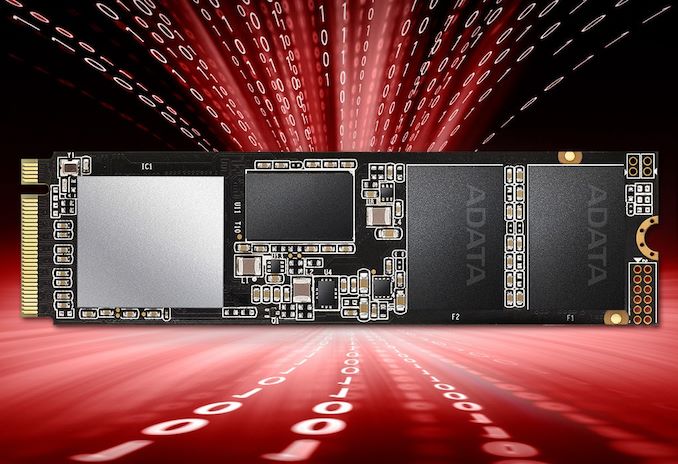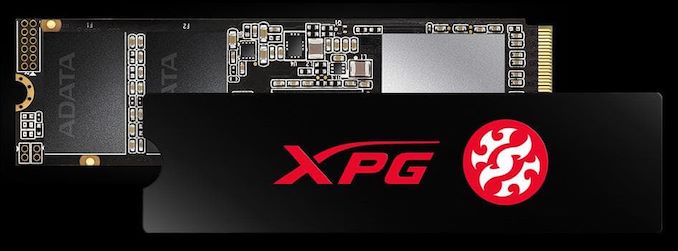ADATA Expands XPG SX8200 Pro Range with 2 TB Model
by Anton Shilov on August 12, 2019 6:45 PM EST
Over the past few months we have seen a number of companies announcing high-end 2 TB PCIe 4.0 x4 M.2-2280 SSDs, which was not particularly surprising given positioning of these drives as well as expected lonf lifecycle on the market. What is a bit more surprising is that some manufacturers are also expanding their existing product lineups with 2 TB SSDs as NAND prices continue to fall. One of such companies is ADATA, which has just released a 2 TB flavor of its XPG SX8200 Pro.
ADATA’s XPG SX8200 Pro is a version of the company’s Gammix S11 Pro without an aluminum heat spreader, which ensures compatibility with laptops. Both drives come in the M.2-2280 form-factor and feature a PCIe 3.0 x4 interface, they are based on Silicon Motion’s SM2262EN controller (eight NAND channels, four ARM Cortex-R5 cores, NVMe 1.3, LDPC ECC, RAID engine, etc.) accompanied by Micron’s 3D TLC NAND. Previously, these drives only featured 256 GB, 512 GB, and 1 TB configurations, but recently ADATA expanded the family with a 2 TB model.
As for performance, the manufacturer claims that the top-of-the-range XPG SX8200 Pro 2 TB drive offers up to 3.5 GB/s sequential read speed and up to 3 GB/s sequential write speed when pSLC caching is used (data based on CDM benchmark), as well as up to 360K random read/write 4K IOPS. The drive is rated for 1280 TB over a 5-year warranty period.
| ADATA XPG SX8200 Pro Specifications | ||||
| Capacity | 256 GB | 512 GB | 1 TB | 2 TB |
| Model Number | ASX8200PNP-256GT-C | ASX8200PNP-512GT-C | ASX8200PNP-1TT-C | ASX8200PNP-2TT-C |
| Controller | Silicon Motion SM2262EN | |||
| NAND Flash | IMFT 3D TLC NAND | |||
| Form-Factor, Interface | M.2-2280, PCIe 3.0 x4, NVMe 1.3 | |||
| Sequential Read | 3500 MB/s | |||
| Sequential Write | 1200 MB/s | 2300 MB/s | 3000 MB/s | |
| Random Read IOPS | 220K IOPS | 390K IOPS | 360K IOPS | |
| Random Write IOPS | 290K IOPS | 380K IOPS | 360K IOPS | |
| Pseudo-SLC Caching | Supported | |||
| DRAM Buffer | Yes, capacity unknown | |||
| TCG Opal Encryption | No | |||
| Power Management | DevSleep, Slumber (0.14 W). | |||
| Warranty | 5 years | |||
| MTBF | 2,000,000 hours | |||
| TBW | 160 TB | 320 TB | 640 TB | 1280 TB |
| Additional Information | Link | |||
ADATA’s 2 TB XPG SX8200 Pro is already available in the US for $289.99, in select European countries (from eBay) for about €306 ~ €308, and in Japan for ¥36,680.
Related Reading:











19 Comments
View All Comments
Alistair - Monday, August 12, 2019 - link
nice, this has been the best deal for a high performance 1TB drive in Canada for almost a year, was really hoping a 2tb would release!voodoobunny - Monday, August 12, 2019 - link
"ADATA’s 2 TB XPG SX8200 Pro is already available in the US for $289.99"If recent price drops are anything to go by, this should be at price-parity with the Intel 660p by Christmas.
(which means, *you* get a 2TB! And *you* get a 2TB! And *you* get a 2TB! *Everybody* gets a 2TB! because it will be way *better* than the 660p...)
PEJUman - Tuesday, August 13, 2019 - link
660p is QLC nand and as a result will always use half of the TLC counterparts. Considering both NANDs are made by Micron (what used to be Micron/Intel JV), I imagine pricing will always scale similarly... $180/$300 for 2TB QLC/TLC.So if you can get $200 2TB TLC using micron NAND in BF’19, I am betting the 660p 2TB QLC will be ~$120.
Bulat Ziganshin - Tuesday, August 13, 2019 - link
why half? qlc/tlc = 4/3 and it doesn't include controller (which is more complex for tlc if you are goinf to reach the same perfromance). so for $200 tlc drive, equivalent qlc should be $170-180PEJUman - Tuesday, August 13, 2019 - link
2Tb 660p is selling now for $180 in US.I am not saying it scales perfectly, ergo the ~ sign. But controller and Dram is not $100, probably closer to $20-30, rest is NAND.
PEJUman - Tuesday, August 13, 2019 - link
It Doubles between version because SLC:MLC:TLC:QLC is an increasing bit count. 1 bit, 2 bits, 3 bits, and 4 bits. Meaning 2:4:8:16 voltage level.frenchy_2001 - Tuesday, August 13, 2019 - link
Voltage levels double each time, stored bits do not.SLC->MLC 1bit->2bits = double
MLC->TLC 2bits->3bits = 50% more
TLC->QLC 3bits->4bits = 33% more
This is bits/celll, but cell sizes are not necessarily the same (or even using the same tech).
So far, biggest bit production boost has been from added layers in 3D NAND.
PEJUman - Tuesday, August 13, 2019 - link
4 bits is 16 levels = 0000,0001,0010,0011,...11113 bits is 8 levels = 000. 001, 010, 011, ... 111
Bits are binary system, each digit increment meant doubling.
Similarly, decimal (0 thru 9), where each digit increment meant 10 fold increase.
Almost all of the modern NAND are 3D, with layers varying from 32 to 96, and soon beyond.
TheUnhandledException - Tuesday, August 13, 2019 - link
The number of levels double but the number of bits does not. 4 bit per cell vs 3 bit per cell is only 33% more bits per cell. If you have flash with 1 billion cells then if it is TLC then it would be 3 Gb and if it is QLC it would be 4 Gb.Fulljack - Tuesday, August 13, 2019 - link
have been using the 512GB version since this May. can confirm this is a real good hardware